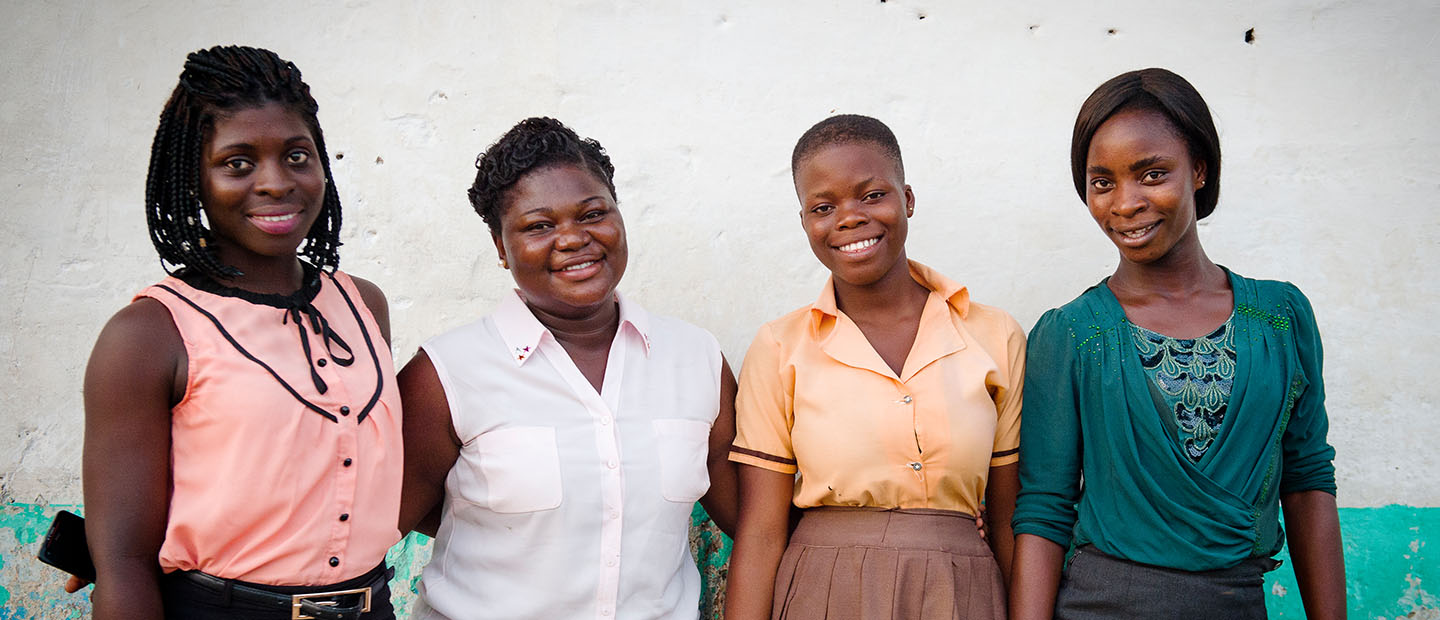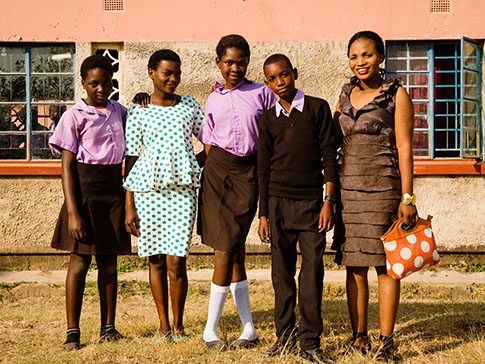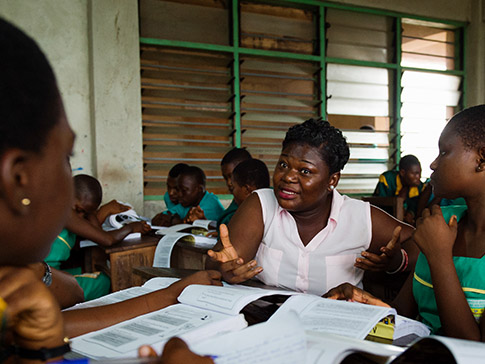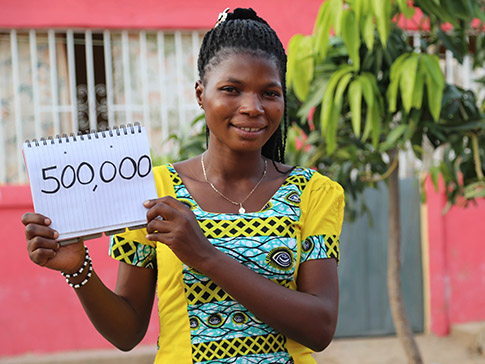
3 ways young women are championing quality education to transform a continent

On Wednesday 9 May, CAMFED’s Executive Director – Canada & Global Programs, Dolores Dickson, will deliver a keynote speech at WISE@Accra.
The theme of the forum is ‘Unlocking the World’s Potential: Leading and Innovating for Quality Education in Africa.’ In this blog post, Dolores demonstrates how the CAMA alumnae network is galvanizing communities to unlock the potential of their children and young people through quality education:
By 2100, the global population is forecast to stand at over 11 billion, and 4 billion of that number could be Africans. The current population of sub-Saharan Africa is already well over 1 billion, with an estimated median age of 19. This youth bulge, caused as child mortality rates fall but birth rates remain stable, has the potential to make or break our collective future.
One of the biggest challenges for the already burgeoning youth population in many African nations is widespread unemployment, which not only perpetuates a cycle of poverty and hopelessness, and hampers development, but can also lead to political instability. Yet an energetic, educated youthful population presents the continent with an extraordinary opportunity to kick-start economic growth and solve global challenges.
CAMFED has stayed optimistic over the last 25 years, because we know that educating girls and supporting young women’s leadership presents a powerful solution to our global concerns. We have evidence of the success of this approach in the CAMA alumnae network, a youth leadership movement of educated and empowered young women. Now a network 120,000-strong across Africa, these young women are using their skills and lived experience to tackle inequality, break the cycle of poverty, and create opportunity for this generation of young people.
Here are three ways they are using dynamic youth leadership to transform marginalized communities through education in the classroom and beyond:
1. Giving back

Mwamba (right) with children she supports in education (Photo: Eliza Powell/CAMFED)
With education and training Mwamba has set up successful businesses, including a restaurant and a hair salon. With the profits she supports four orphaned children in their education, steering them on a path to productive employment.
I feel very happy because I am influencing change in other people’s lives so that they can achieve the same things that I have.
Mwamba, CAMA Member, Zambia
On average each CAMA member supports at least two children outside her own family to go to school. By 2017, CAMA members had collectively supported more than 780,000 children to go to primary and secondary school.
This is a powerful kind of philanthropy. These young women know the indignity of poverty; they remember going to school on an empty stomach, wondering how they would get a new exercise book, being embarrassed by their torn clothes. So they are committed to helping another girl receive a nutritious meal, stationery or a school skirt. For marginalized children this could be the difference between dropping out or completing school. It can also help the young women reach their own goals, whether achieving a BTEC qualification through CAMFED’s Learner Guide Programme or gaining access to a business loan with our Youth Enterprise initiatives.
2. Acting as role models
As a CAMA Leader, Pearl is a role model to her peers as well as younger girls. She combines mentoring students as a Learner Guide with her own university studies, running a business, and meeting with traditional leaders, school heads and families to advocate for girls’ education.
The world we live in is not a matter of having…it’s about giving. I am not only dreaming about changing the world. I am changing it.
Pearl, CAMA Leader, Ghana
Many girls in rural, sub-Saharan Africa grow up without a female role model who has completed education and holds a professional role. Teachers are mostly male (65% in Tanzania), as are traditional leaders and local officials.

Pearl is active in community work including mentoring the next generation (Photo: Eliza Powell/CAMFED)
Girls may know only the paths of female relatives, many of whom were forced to drop out of school, and perhaps entered into early marriage and childbearing. In rural areas women often live a meagre existence — in sub-Saharan Africa 74% of women in non-agricultural jobs are in informal employment. How eye-opening then, to see young women in the community who are educated and becoming teachers, nurses or entrepreneurs — who can bring in a regular income, and take agency over their life choices, having smaller, healthier families, and ensuring their own children are educated.
3. Delivering life skills

Dorcas aims to reach 500,000 women and girls through her community work (Photo: Sarah Winfield/CAMFED)
Dorcas won’t sit by and let people in her community endure the same hardships year after year. She’s tackling the key issues head on: educating girls about the dangers of early pregnancy and giving women a lifeline through skills like basket-weaving and shea butter production.
I want to help other people so that they don’t suffer… I never give up. I want to get to the highest level so that I can help the deprived people in society.
Dorcas, CAMA Member, Ghana
Not just on the peripheries of the education system, CAMA members become involved both in and out of schools to equip members of the community with life skills which are absent from an academic curriculum that lacks relevance to young people’s reality.
With youthful energy and passion for education they pass on knowledge, change gender stereotypes and bring hope. CAMA members are trained to deliver sessions on topics including sexual and reproductive health and income-generating skills. A recent study found that following enterprise training, young women in Zambia had reached 11,000 people with financial literacy skills. Working in collaboration with people at all levels they are reinvigorating communities with the skills and means to support their children in education.
With the backing of the international community, young leaders like Mwamba, Pearl and Dorcas have the potential to steer Africa away from crisis and towards opportunity. As philanthropists, role models and educators who understand the local context, they are the key to a positive future for Africa and for us all.
Sources:
1. ‘World population projected to reach 9.8 billion in 2050, and 11.2 billion in 2100’ – United Nations, Department of Economic and Social Affairs [online]. Available at: https://www.un.org/development/desa/en/news/population/world-population-prospects-2017.html [Accessed on 8 May 2018].
2. May, J and Groth, H (2017). ‘Failure to address Africa’s rising population is not an option’ – Financial Times [online]. Available at: https://www.ft.com/content/a2ccd284-5668-11e7-80b6-9bfa4c1f83d2 [Accessed on 8 May 2018].
3. ‘Sub-Saharan Africa’ – The World Bank, Data [online]. Available at: https://data.worldbank.org/region/sub-saharan-africa [Accessed on 8 May 2018].
4. Atta-Asamoah, A and Severino, J-M (2014). ‘Head-to-head: Is Africa’s young population a risk or an asset?’ – BBC News [online]. Available at: https://www.bbc.co.uk/news/world-africa-25869838 [Accessed on 8 May 2018].
5. ‘Mastercard Foundation Announces Ambitious Commitment to Address Youth Unemployment in Africa’ – Mastercard Foundation [online]. Available at: https://www.mastercardfdn.org/mastercard-foundation-announces-ambitious-commitment-to-address-youth-unemployment-in-africa-2/ [Accessed on 8 May 2018].
6. ‘Women in informal economy’ – UN Women [online]. Available at: https://www.unwomen.org/en/news/in-focus/csw61/women-in-informal-economy [Accessed on 8 May 2018].
